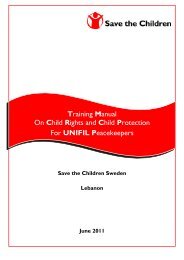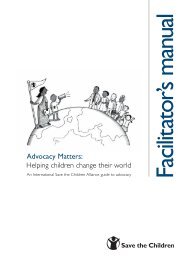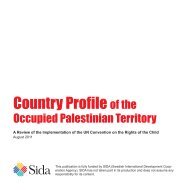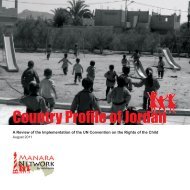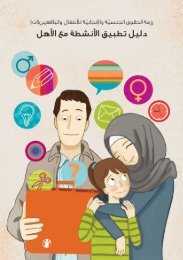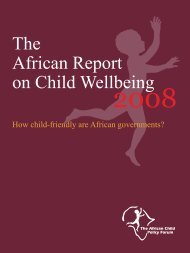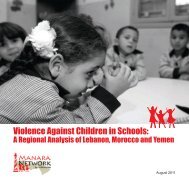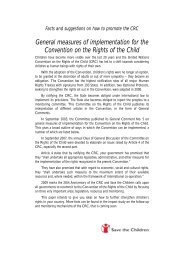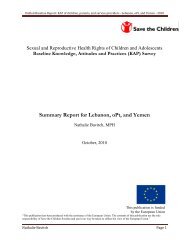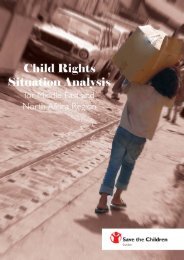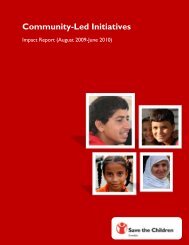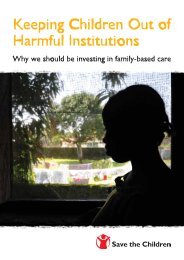Country Profile of Morocco - International Bureau of Children's Rights
Country Profile of Morocco - International Bureau of Children's Rights
Country Profile of Morocco - International Bureau of Children's Rights
Create successful ePaper yourself
Turn your PDF publications into a flip-book with our unique Google optimized e-Paper software.
children in difficult circumstances, through which child<br />
victims <strong>of</strong> trafficking can be supported.<br />
h. Children Associated<br />
with Armed Forces and Armed Groups<br />
The conflict between <strong>Morocco</strong> and the Polisario Front<br />
over the independence <strong>of</strong> the Sahara territory has lasted<br />
for over 30 years. The Polisario Front depends mainly on<br />
the recruitment <strong>of</strong> volunteers, although the minimum age<br />
for enrolment and military training is 18 years old.<br />
<strong>Morocco</strong>, on the other hand, has revised its age <strong>of</strong> compulsory<br />
recruitment to age 20.<br />
The Committee, in its Concluding Observations <strong>of</strong> 2003,<br />
recommended that the Government “take all feasible<br />
measures to ensure full protection and care <strong>of</strong> children<br />
who are affected by the armed conflict taking place in<br />
Western Sahara.” 215<br />
According to the Coalition to Stop the Use <strong>of</strong> Child<br />
Soldiers, there have been no reports <strong>of</strong> children under the<br />
age <strong>of</strong> 18 enlisted in the Royal Armed Forces <strong>of</strong> <strong>Morocco</strong><br />
nor within the People’s Liberation Army, the armed wing<br />
<strong>of</strong> Polisario.<br />
In October 2007, <strong>Morocco</strong> endorsed the Paris Commitments<br />
to Protect Children from Unlawful Recruitment<br />
as well as the Paris Principles and guidelines on children<br />
associated with armed forces or armed groups. 216<br />
i.<br />
41<br />
Landmines and Small Arms<br />
<strong>Morocco</strong> is not considered an area affected by landmines,<br />
with the exception <strong>of</strong> the “controlled” territory in Western<br />
Sahara, which could be contaminated by landmines<br />
and explosive remnants <strong>of</strong> war. 217 It was reported that<br />
<strong>Morocco</strong> placed landmines around the three-meter wall it<br />
constructed in the Western Sahara region 218 , but the exact<br />
extent <strong>of</strong> contamination is unknown. Landmine and Cluster<br />
Munition Monitor says that the Western Sahara may<br />
have the highest number <strong>of</strong> landmines in the world. 219<br />
<strong>Morocco</strong> reported three or four cases <strong>of</strong> persons injured<br />
by landmines in 2007. 220 A new victim was identified by<br />
the Landmine Monitor in <strong>Morocco</strong> in 2007: a 12-year-old<br />
girl who was wounded by an unidentified explosive device<br />
in Assa (just outside the Western Sahara territory). In<br />
2003, the Committee had no comments or recommendations<br />
on this issue.<br />
Landmine and Cluster Monitor reports that after the<br />
death <strong>of</strong> a Moroccan <strong>of</strong>ficial in a landmine in January<br />
2007, <strong>Morocco</strong> embarked on a major demining effort. 221<br />
Specific actions promoting the protection <strong>of</strong> children<br />
could not be found.<br />
j.<br />
Orphaned, Separated and Unaccompanied Children<br />
The number <strong>of</strong> children deprived from a home environment<br />
is growing in <strong>Morocco</strong>. Between 2002 and 2004, the<br />
number <strong>of</strong> children living in institutions increased from<br />
29,304 to 46,500. 222 These children have <strong>of</strong>ten been placed<br />
in these institutions by poor parents and are subsequently<br />
subject to insufficient supervision, violence and abuse. 223<br />
The 2002 Act on the Kafala makes the Islamic form <strong>of</strong><br />
adoption subject to a court decision where the rights and<br />
duties <strong>of</strong> parties are regulated. The Act also allows the<br />
adopted father to give his name to the child in a process<br />
called the “unification <strong>of</strong> the family name”. 224 However,<br />
according to several families engaged in the kafala process,<br />
this procedure is very complicated and can take a long<br />
time.




